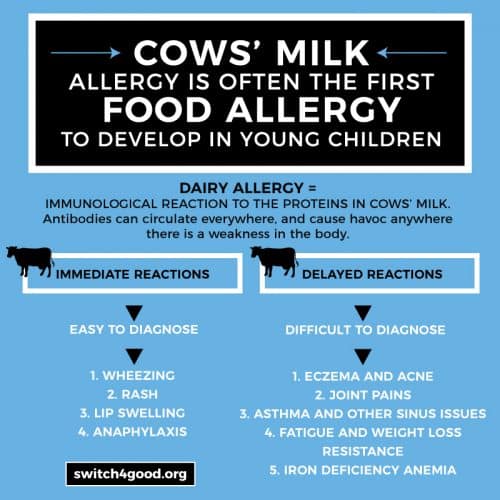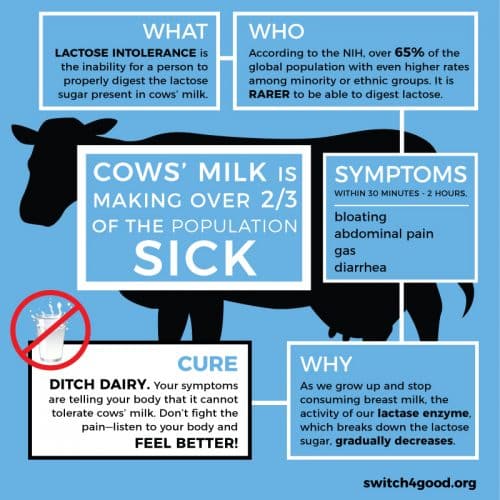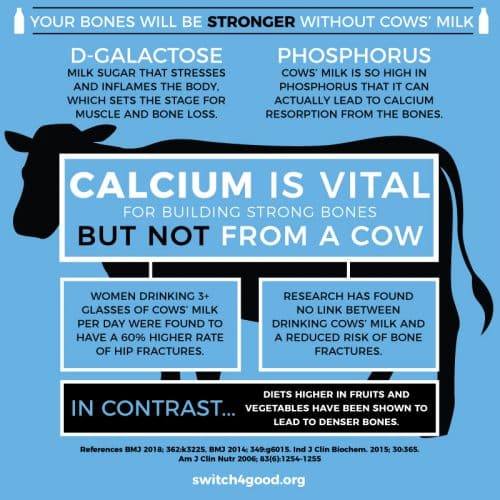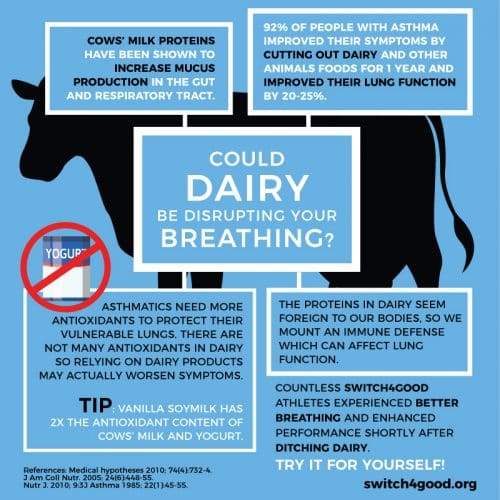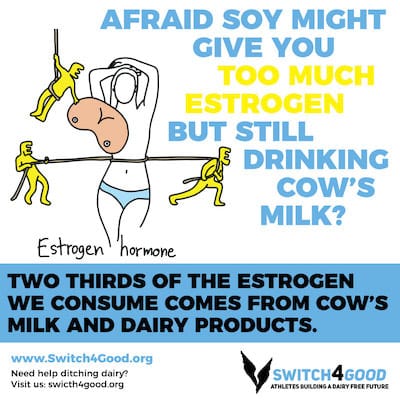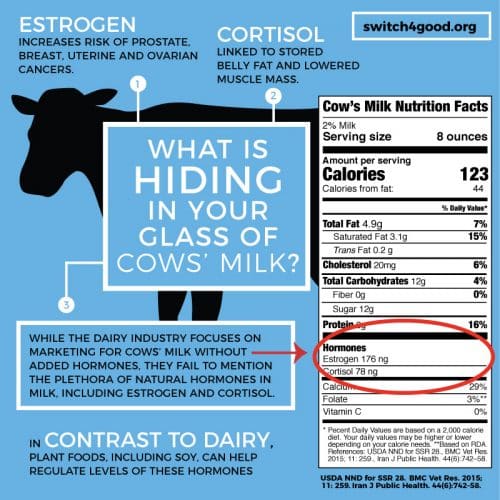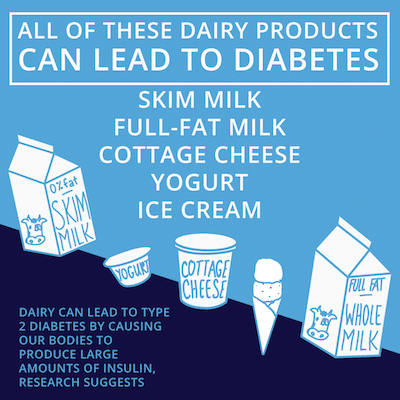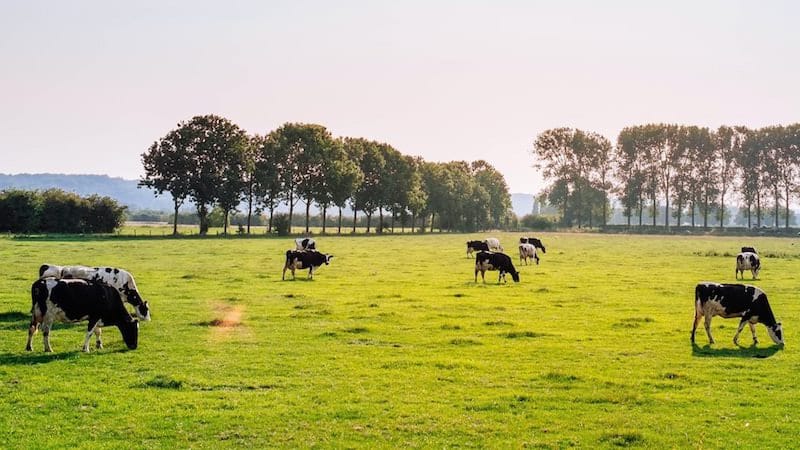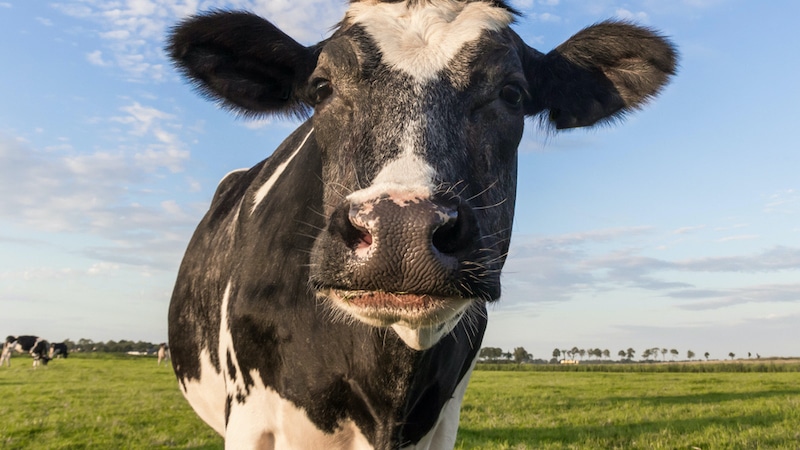Health & Performance
Cows’ Milk Allergy
Did you know that cows’ milk allergies might be more common than allergies to peanuts, shellfish, and eggs? Cows’ milk allergy mostly affects infants and children, but also up to 1 in 13 adults! (1) Further, a meta-analysis of 51 studies on the prevalence of food allergies found that up to 17% of people self-report an allergy to cows’ milk (2).
In addition to the immediate symptoms that can occur, such as wheezing, hives, vomiting, and life-threatening anaphylaxis, some symptoms can actually occur up to several days following dairy consumption, including eczema and acid reflux (3). This means people may not even realize their symptoms could be an allergic reaction to the cows’ milk they consumed days prior. Unfortunately, methods for reversing cows’ milk allergy, such as immunotherapy, have not been proven safe or effective, which is why doctors recommend avoiding dairy products entirely (4). Think you could be affected? Learn about the 4 Signs That You May Be Allergic to Dairy by Switch4Good expert, Dr. Vivian Chen.
Our tip to you: avoid all forms of dairy to manage symptoms, including milk from sheep and goats. Click here to learn about alternatives to cows’ milk.
Learn more:
Dr. Vivian Chen: On Allergies, Gut Health, And Food As Medicine
Time To Rethink Your Child’s Daily Dairy
References →
2. Rona, Roberto J. et al. The prevalence of food allergy: A meta-analysis. Journal of Allergy and Clinical Immunology 2007; 20(3):638 – 646.
3. Fiocchi et al. World Allergy Organization (WAO) Diagnosis and Rationale for Action against Cow’s Milk Allergy (DRACMA) Guidelines. WAO Journal 2010.
4. Taniuchi S, Takahashi M, Soejima K, Hatano Y, Minami H. Immunotherapy for cow’s milk allergy. Hum Vaccin Immunother. 2017; 13(10):2443–2451.
Lactose Intolerance
How can cows’ milk be considered a health food when 65% of the world’s population is intolerant to it? Once someone who is lactose intolerant consumes cows’ milk or other lactose-containing dairy products, symptoms can occur within 30 minutes to two hours! (1) The struggle is real. These symptoms include abdominal pain, bloating, gas, nausea, and diarrhea (1). Cows’ milk is making those who are lactose intolerant sick.
According to the National Institute of Health, 65% of adults experience dairy intolerance, a generally lifelong inherited condition characterized by varying levels of difficulty digesting lactose (dairy sugar) (2). This condition is commonly referred to as lactose intolerance.
Our tip to you: completely avoid lactose by passing on the milk, cheese, butter, cream, and other dairy products. Click here to read Switch4Good expert Dr. Angie Sadeghi’s breakdown of lactose intolerance. If you think you might be lactose intolerant, take our test to find out!
Learn more:
Lactose Intolerance Explained
4 Unexpected Signs You May Be Allergic To Dairy
References →
2. Swagerty et al. Lactose Intolerance. Am Fam Physician 2002; 65:1845-50,1855-6
Bone Density
Don’t be fooled by advertisements claiming that cows’ milk helps strengthen bones—the research tells a different story. A 2018 meta-analysis involving over 250,000 male and female subjects found no link between drinking cows’ milk and a reduced risk of bone fractures (1). In fact, according to a study published in the British Medical Journal, those getting the USDA “recommended” 3+ glasses per day had a whopping 60% greater hip fracture rate (2).
Yup, cows’ milk could actually make bones more brittle, not stronger. How can this be? Researchers suggest the milk sugar D-galactose promotes oxidative stress and inflammation, which are both linked to loss of muscle and bone (2). Additionally, while phosphorus is essential for calcium absorption, too much can be counter productive. Cows’ milk is so high in phosphorus that it can actually lead to calcium resorption from the bones (3).
Our tip to you: for truly strong bones eat more fruits and vegetables! The foods highest in calcium and 50% more bioavailable than the calcium in cows’ milk are almonds, kidney beans, and most dark, leafy greens (4). Diets higher in fruits and vegetables have been shown to lead to denser bones in younger and older adults (5,6).
Learn more:
Basic Bone And Major Muscle Strengthening Workout
Dairy Industry Creates ‘Calcium Crisis’ To Sell Cows’ Milk
5 Tips To Maintain Strong Bones And Prevent Osteoporosis
References →
2. Michaëlsson K, Wolk A, Langenskiöld S, et al. Milk intake and risk of mortality and fractures in women and men: cohort studies. BMJ 2014; 349:g6015.
3. Mahdi, A.A., Brown, R.B. & Razzaque, M.S Osteoporosis in Populations with High Calcium Intake: Does Phosphate Toxicity Explain the Paradox? Ind J Clin Biochem. 2015; 30:365.
4. Amy Joy Lanou. Should dairy be recommended as part of a healthy vegetarian diet? Counterpoint. The American Journal of Clinical Nutrition 2009; 89(5):1638S–1642S.
5. Katherine L Tucker et al. Potassium, magnesium, and fruit and vegetable intakes are associated with greater bone mineral density in elderly men and women. The American Journal of Clinical Nutrition 1999; 69(4):727–736.
6. Susan A Lanham-New. Fruit and vegetables: the unexpected natural answer to the question of osteoporosis prevention? The American Journal of Clinical Nutrition 2006; 83(6):1254–1255
Asthma
Cow’s milk and other dairy products have been shown to increase mucus production in the body, which is a hallmark symptom of asthma (1). Researchers hypothesize that increased intestinal permeability, which has been associated with strenuous exercise, allows the casein protein to leak through the gut and therefore stimulate excess mucus production (2,3).
Asthmatics need more antioxidants to protect their vulnerable lungs, as they have far fewer antioxidants than most (4). By eating more foods that contain these antioxidants, they could reduce the chance of worsening symptoms by half! (5) It sounds so simple, but not for those who still consume dairy products. Unfortunately, there are not many antioxidants in dairy, so relying on dairy products may actually lead to worsening symptoms.
Our tip to you: try some chocolate soymilk. Chocolate soymilk from Trader Joe’s contains almost double the antioxidant content of store brand chocolate cows’ milk (6). This may explain why an astounding 92% of people with asthma who cut out dairy and other animal foods for one year improved their symptoms enough to go from 4-5 medications to just 1! (7) To learn more about how to include more antioxidant-rich foods into your diet click here.
Learn more:
NFL & Olympic Nutritionist: How Food Affects Athletic Performance
4 Unexpected Signs You May Be Allergic To Dairy
Dairy Facts For Those Who Ask
References →
2. Bartley, Jamie and Susan Read McGlashan. Does milk increase mucus production? Medical hypotheses 2010; 74(4):732-4.
3. JanssenDuijghuijsen, Lonneke M et al. The effect of endurance exercise on intestinal integrity in well-trained healthy men. Physiological reports vol. 4,20 (): e12994.
4. Lisa G. Wood et al. Airway and circulating levels of carotenoids in asthma. J Am Coll Nutr. 2005; 24(6):448-55.
5. Lisa G Wood et al. Manipulating antioxidant intake in asthma: a randomized controlled trial. The American Journal of Clinical Nutrition 2012; 96(3):534–543.
6. Carlsen MH, Halvorsen BL, Holte K, et al. The total antioxidant content of more than 3100 foods, beverages, spices, herbs and supplements used worldwide. Nutr J. 2010; 9:3
7. Lindahl O, Lindwall L, Spångberg A, Stenram A, Ockerman PA. Vegan regimen with reduced medication in the treatment of bronchial asthma. J Asthma 1985; 22(1):45-55.
Cancer
For the latest studies on dairy cheese and cancer, see here.
Ovarian Cancer
Research links cow’s milk to increased risk of ovarian cancer. In a study examining the incidence rates of ovarian cancer in 40 countries across 5 continents, researchers found they were most closely correlated with cow’s milk intake (1). The researchers suggest that women who drank just 1 or more glasses of whole cow’s milk per day were at three times greater risk for ovarian cancer (1). Skim milk has also been tied to this deadly disease.
Our tip to you: Eat more vegetables! Although dairy consumption can increase the risk of developing ovarian cancer, vegetables can reduce it (2). Eating 3 or more servings of vegetables per day can decrease ovarian cancer risk by 39% (3).
References →
2. Susanna C Larsson, Leif Bergkvist, Alicja Wolk. Milk and lactose intakes and ovarian cancer risk in the Swedish Mammography Cohort. The American Journal of Clinical Nutrition 2004; 80(5):1353-1357.
3. Larsson SC, Holmberg L, Wolk A. Fruit and vegetable consumption in relation to ovarian cancer incidence: the Swedish Mammography Cohort. Br J Cancer 2004; 90(11):2167–2170.
Prostate Cancer
Research links cow’s milk to increased risk of prostate cancer. According to the American Cancer Society, American men have a 1 in 9 chance of developing prostate cancer—the second most common to skin cancer. Drinking cow’s milk each day can increase a boy’s risk of advanced prostate cancer threefold! (2) The same can be said for adults. A study of men across 42 countries revealed that cow’s milk was more closely linked to the development of prostate cancer than any other food (3). In fact, a primary research study found a 60% higher relative risk for those men consuming 2 cow’s milk servings per day compared to zero servings per day (4). Why might this be? Some researchers suggest it may be in part due to the high dietary phosphate content of cow’s milk (5), while others suggest that cow’s milk proteins can activate an enzyme whose signaling pathway can initiate prostate cancer development (6).
Our tip to you: Research shows that men who ditched dairy and opted for a plant-based diet were able to cut their risk of prostate cancer by 35% (7). We suggest ditching dairy to lower your risk.
References →
2. Torfadottir JE, Steingrimsdottir L, Mucci L, et al. Milk intake in early life and risk of advanced prostate cancer. Am J Epidemiol. 2012; 175(2):144–153.
3. Ganmaa, D. , Li, X. , Wang, J. , Qin, L. , Wang, P. and Sato, A. Incidence and mortality of testicular and prostatic cancers in relation to world dietary practices. Int. J. Cancer 2002; 98:262-267.
4. Edward Giovannucci et al. Calcium and Fructose Intake in Relation to Risk of Prostate Cancer. Cancer Res. 1998; 58(3):442-447.
5. Newmark HL, Heaney RP. Dairy products and prostate cancer risk. Nutr Cancer. 2010; 62(3):297-9.
6. Melnik BC, John SM, Carrera-Bastos P, Cordain L. The impact of cow’s milk-mediated mTORC1-signaling in the initiation and progression of prostate cancer. Nutr Metab (Lond). 2012; 9(1):74.
7. Tantamango-Bartley Y, Knutsen SF, Knutsen R, et al. Are strict vegetarians protected against prostate cancer? Am J Clin Nutr. 2016; 103(1):153–160.
Breast Cancer
Research links cow’s milk to increased risk of breast cancer. A study of breast cancer cases that surveyed 40 countries across five continents revealed that cow’s milk was the second food most correlated with breast cancer (the first was meat) (1). Researchers suggest that since the cow’s milk we consume today is produced from pregnant cows, in which estrogen and progesterone levels are elevated, this can have adverse effects on the body and potentially stimulate the development of breast cancer (1).
Additionally, research has shown that cows’ milk increases our circulating levels of insulin-like growth factor (IGF-1), a growth-stimulating hormone, which can lead to unregulated cell growth, a characteristic of cancer (2). IGF-1 has also been shown to play a role in increasing other known risk factors for breast cancer, such as greater adult height, number of menstrual cycles, and higher birth weight (3).
Our tip to you: Don’t be afraid to consume soy! Circulating estrogen levels decreased by 50% in women who drank soy milk every day and stayed down for one month even after they stopped drinking it (4). Soybeans contain phytoestrogens which not only can act as estrogen blockers (5), but also inhibit breast cancer cells from producing estrogen in the first place (6).
References →
2. Christopoulos PF, Msaouel P, Koutsilieris M. The role of the insulin-like growth factor-1 system in breast cancer. Mol Cancer. 2015; 14:43.
3. Djamil Maliou, Arezki Bitam. Implication of milk and dairy products consumption through insulin-like growth factor-I in induction of breast cancer risk factors in women. Nutrition Clinique et Métabolisme, 2015; 29(4):219-225
4. Lu LJ, Anderson KE, Grady JJ, Nagamani M. Effects of soya consumption for one month on steroid hormones in premenopausal women: implications for breast cancer risk reduction. Cancer Epidemiol Biomarkers Prev. 1996; 5(1):63-70.
5. So FV, Guthrie N, Chambers AF, Carroll KK. Inhibition of proliferation of estrogen receptor-positive MCF-7 human breast cancer cells by flavonoids in the presence and absence of excess estrogen. Cancer Lett. 1997; 112(2):127-33.
6. Brooks JD, Thompson LU. Mammalian lignans and genistein decrease the activities of aromatase and 17beta-hydroxysteroid dehydrogenase in MCF-7 cells. J Steroid Biochem Mol Biol. 2005; 94(5):461-7.
Learn more:
Study Finds Dairy (Not Soy) Skyrockets Breast Cancer Risk
The Link Between Dairy And Prostate Cancer Is Too Significant To Ignore
Largest Comprehensive Study Of Nutrition Links Dairy And Disease
Hormones
It is common knowledge that proper hydration is essential to any form of exercise, but chocolate milk is not the drink of champions. Cows’ milk, even “no hormone added,” “grass-fed,” and “locally produced,” contains 15 different sex hormones, including estrogen, progesterone and testosterone. That does not even include the other 60 natural hormones found in cows’ milk and the synthetic hormones many dairy cows are given to boost milk production. Consuming these large amount of hormones can lead to a wide array of unwanted side effects and even cancer. To learn more about the toxic effects of hormones in today’s cows’ milk from Dr. Vivian Chen, click here.
ESTROGEN
Cows’ milk and dairy products are full of estrogen hormones. These products supply 60-80% of the estrogen in our diets (1). This is due to the fact that the milk people consume is taken from pregnant cows. Modern genetically-improved dairy cows, such as the Holstein, lactate during the latter half of pregnancy, when estrogen levels are highly elevated (2). In fact, just 30-60 minutes after drinking milk, estrogen levels can increase by 26%! (2) Numerous studies have found an association between excess estrogen and increased risk of breast and prostate cancers, fatigue, and weight gain (3,4).
Our tip to you: Pomegranate juice! Pomegranates contain aromatase inhibitors like ellagetanins which inhibit estrogen production (5). It is also a great anti-inflammatory food. Compared to drinking a placebo, pomegranate juice can increase Olympic weightlifting performance by 8%, decrease how hard training felt by 4%, and decrease muscle soreness by 13%! (6) And don’t be afraid of soy. Soy actually contains phytoestrogens which act as estrogen blockers (7).
References →
2. Maruyama K, Oshima T, Ohyama K. Exposure to exogenous estrogen through intake of commercial milk produced from pregnant cows. Pediatr Int. 2010 ;52(1):33-8.
3. Ganmaa D, Sato A. The possible role of female sex hormones in milk from pregnant cows in the development of breast, ovarian and corpus uteri cancers. Med Hypotheses 2005; 65(6):1028-37.
4. Ganmaa D, Wang PY, Qin LQ, Hoshi K, Sato A. Is milk responsible for male reproductive disorders? Med Hypotheses. 2001; 57(4):510-4.
5. Adams LS, Zhang Y, Seeram NP, Heber D, Chen S. Pomegranate ellagitannin-derived compounds exhibit antiproliferative and antiaromatase activity in breast cancer cells in vitro. Cancer Prev Res (Phila). 2010; 3(1):108–113.
6. Ammar A, Turki M, Chtourou H, et al. Pomegranate Supplementation Accelerates Recovery of Muscle Damage and Soreness and Inflammatory Markers after a Weightlifting Training Session. PLoS One. 2016; 11(10):e0160305.
7. Fioravanti L, Cappelletti V, Miodini P, Ronchi E, Brivio M, Di Fronzo G. Genistein in the control of breast cancer cell growth: insights into the mechanism of action in vitro. Cancer Lett. 1998; 130(1-2):143-52.
CORTISOL
We are always trying to find ways to decrease our stress levels, as stress can reap terrible effects stress can have on our minds and bodies. Stress is often controlled by a hormone known as cortisol—a stress hormone consistently found in cows’ milk (1). To make matters worse, high cortisol levels cause us to store belly fat (2) and are linked to lower muscle mass and bone density (3). Consuming excess cortisol is definitely not going to help us lower our stress levels, and no one needs more stress in their lives.
Our tip to you: While dairy-laden meals have been shown to increase cortisol, research shows that barley soup and vegetable stir-frys with rice can lower levels of this high stress hormone (4).
References →
2. Björntorp P. Do stress reactions cause abdominal obesity and comorbidities? Obes Rev. 2001; 2(2):73-86.
3. Schorr M, Lawson EA, Dichtel LE, Klibanski A, Miller KK. Cortisol Measures Across the Weight Spectrum. J Clin Endocrinol Metab. 2015;100(9):3313–3321.
4. Gibson EL, Checkley S, Papadopoulos A, Poon L, Daley S, Wardle J. Increased salivary cortisol reliably induced by a protein-rich midday meal. Psychosom Med. 1999; 61(2):214-24.
INSULIN-LIKE GROWTH FACTOR-1
Milk naturally contains a hormone called Insulin-like Growth Factor-1 (IGF-1), a growth stimulating hormone. The whey protein naturally present in milk further stimulates our body’s production of IGF-1 by a pathway called mTOR, further increasing our circulating levels of this hormone (1). Consuming cows’ milk leads to a 10–20% increase of circulating IGF‐1 in adults, and to a 20–30% increase in children (3).
We need IGF-1 is involved in the maturation and differentiation of many cells and organs; in other words, it is vital for growth and development. However, excess IGF-1 from consumption of cows’ milk can interfere with these processes and has been associated with accelerated linear growth, altered fetal development, atherosclerosis, weight gain, acne, autoimmunity, and even neurodegenerative diseases (3). Additionally, IGF-1 receptors are present on most cancer cells. Excess IGF-1 can bind to these receptors and stimulate cancer cells to grow more quickly (2). This may explain why IGF-1 has been linked to breast, cervical, ovarian, endo‐metrial, colorectal and prostate cancers (2,3).
Our tip to you: IGF-1 is a goldilocks hormone whereby you don’t want too much, and you don’t want too little. Exercise and, in particular, strength training is a great way to naturally boost your IGF-1 levels without causing excess. Removing dairy products is a simple and effective way to control IGF-1 and reduce your risk of cancer, type 2 diabetes, and acne. Watch this video to hear from Dr. Milton Mills on how cows’ milk does NOT do a body good!
References →
2. Melnik BC, John SM, Schmitz G. Over-stimulation of insulin/IGF-1 signaling by western diet may promote diseases of civilization: lessons learnt from laron syndrome. Nutr Metab (Lond). 2011;8:41.
3. Melnik, B. Milk consumption: aggravating factor of acne and promoter of chronic diseases of Western societies. JDDG: Journal der Deutschen Dermatologischen Gesellschaft 2009; 7: 364-370.
Learn more:
Soy: Alleviating Fears And Shooting Down The ‘Bro Science’ About This Therapeutic Plant Protein
How Natural Hormones In Dairy Affect Your Fertility
Cardiovascular Health and Inflammation
Years of research has told us that consuming foods high in saturated fats, like dairy products, can be detrimental to our cardiovascular health. Most recently, a 2018 study published in Laboratory Investigation not only found changes in size and shape of red blood cells just one hour after consuming a high-fat milkshake but also changed in our immune cell function, setting the stage for inflammation, plaque formation and ultimately heart disease (1).
Not only do dairy foods contain a significant amount of saturated fat, but also more than 2 percent of dairy’s calories come from trans fats (2), a substance deemed as the most harmful fat in our food supply by the Institute of Medicine (3). So harmful, in fact, that there is no upper limit of these fats since any trans-fats increases the risk of cardiovascular heart disease. Trans fats cripple arteries, cutting blood flow to our muscles and promoting inflammation and heart disease (4).
Finally, cows’ milk contains proteins (5) and other foreign components, including sugars such as Neu5gc (6), that many people’s bodies do not recognize, initiating an immune response and promoting further inflammation. (7)
Our tip to you: While the dairy industry is adamant about promoting chocolate milk as a recovery beverage, this sugary drink is far from a health food. Antioxidant-rich foods are a far better alternative, as antioxidants stimulate cardiovascular health, athletic performance, and a speedy recovery by combatting damage done to your cells during your workout. And those are found in plant sources, not dairy food. So, eat more berries instead of dairy! Berries boost artery function and soothe inflammation (8). This will help you perform better and recover faster.
Learn more:
Save Your Life With A Vegan Diet With Dr. Joel Kahn
6 Inflammation-Fighting Foods (Plus Meal Ideas)
References →
2. USDA: Fat and Fatty Acid Content of Selected Foods Containing Trans-Fatty Acids.
3. Institute of Medicine: Dietary Reference Intakes.
4. Mozaffarian D, Katan MB, Ascherio A, Stampfer MJ, Willett WC. Trans fatty acids and cardiovascular disease. N Engl J Med. 2006; 354(15):1601-13. Review.
5. Shek LP, Bardina L, Castro R, Sampson HA, Beyer K. Humoral and cellular responses to cow milk proteins in patients with milk-induced IgE-mediated and non-IgE-mediated disorders. Allergy. 2005 Jul;60(7):912-9
6. Dhar C, Sasmal A and Varki A. From “Serum Sickness” to “Xenosialitis”: Past, Present, and Future Significance of the Non-human Sialic Acid Neu5Gc. Front. Immunol, 2019; 10:807
7. Samraj Annie, Läubli Heinz, Varki Nissi, Varki Ajit.Involvement of a Non-Human Sialic Acid in Human Cancer. Frontiers in Oncology, 2014; 4:33
8. Basu A, Rhone M, Lyons TJ. Berries: emerging impact on cardiovascular health. Nutr Rev. 2010; 68(3):168–177.
Type 2 Diabetes
Research has found that whey protein from cows’ milk to be highly insulinotropic, despite having a low-glycemic index (1). Simply put, dairy products, including full-fat milk, cottage cheese, yogurt, and ice cream cause our bodies to produce large amounts of insulin, which works against type 2 diabetes prevention (1). In fact, drinking a cup of milk with other low-glycemic index foods was found to increase insulin production by an astounding 300% (1). Furthermore, 8-year-old boys who were given skim milk for just one week more than doubled their insulin production (1).
Due to the insulinotropic properties of cows’ milk, consuming this material past weaning causes our bodies to maintain higher than normal levels of the growth-stimulating hormone, Insulin-like Growth Factor 1 (IGF-1) (2). High levels of this hormone constantly stimulate the proliferation of pancreatic cells, which produce insulin. This overstimulation produces excess insulin, damages the cells, and eventually leads to cell death (2).
Ultimately, when our bodies aren’t utilizing insulin properly, blood sugar levels remain high, resulting in hyperglycemia, a hallmark of type 2 diabetes (3).
Our tip to you: Both observational and interventional studies show that a low-fat, plant-based nutritional approach to diet can improve weight control and blood sugar levels (4). Plant foods are perfect for preventing and managing type 2 diabetes. Click here for some mouth-watering dairy-free and plant-based recipes!
Learn more:
Secrets To Mastering Diabetes With Robby Barbara & Cyrus Khambatta
Ditch Dairy To Better Manage Type 1 Diabetes
New Study Links Milk Proteins With Onset Of Diabetes
References →
2. Melnik BC, John SM, Schmitz G. Over-stimulation of insulin/IGF-1 signaling by western diet may promote diseases of civilization: lessons learnt from laron syndrome. Nutr Metab (Lond). 2011;8:41.
3. Wilcox G. Insulin and insulin resistance. Clin Biochem Rev. 2005;26(2):19–39.
4. Trapp CB, Barnard ND. Usefulness of vegetarian and vegan diets for treating type 2 diabetes. Curr Diab Rep. 2010; 10(2):152-8.
Better Digestion
No one performs at their best on an upset or bloated stomach no matter how much they try to ignore the discomfort.
- 65% of the global population is lactose intolerant according to the National Institute of Health. (1) This number is even higher among non-white populations such as Asians, Blacks, and Hispanics. (1)
- Those who cannot effectively digest lactose are considered lactose intolerant and experience uncomfortable symptoms such as abdominal pain, bloating, gas, nausea, and diarrhea—all of which can be a major detriment to training and performance.
- Thankfully, athletes can avoid all of these issues simply by ditching dairy. Stomach issues don’t have to be a “normal” thing; save the grit and pain tolerance for those burning muscles, not your upset stomach.
Learn more
What Is Lactose Intolerance?
Take Our Lactose Intolerance Quiz
Switch4Good Podcast with Gastroenterologist Dr. Angie Sadeghi
References →
Breathe Better
A runner won’t win the race if he’s gasping for air halfway through; a cyclist is out of luck if she needs to wipe her runny nose while climbing a hill; a powerlifter is in serious trouble if she messes up a deadlift while attempting to clear mucus from her throat. All of these issues— impaired breathing, a runny nose, and excess mucus—can all be exacerbated by drinking cows’ milk.
- Cows’ milk proteins, particularly casein which makes up 80% of cows’ milk, have been shown to increase mucus production in the gut and respiratory tract. (1) Researchers hypothesize that increased intestinal permeability, which has been linked to poor diet, disease, and strenuous exercise, allows the casein and other proteins to leak through the gut and therefore stimulate excess mucus production (2,3).
- Cows’ milk proteins seem foreign to the body, so an immune defense is mounted, which can affect lung function, making it more difficult to breathe when we need it most. (2)
- Asthmatic athletes are particularly crippled by drinking dairy, as dairy is devoid of antioxidants which are essential substances that protect asthmatics’ vulnerable lungs. (3). By eating naturally antioxidant-rich plant-based foods, asthmatics can cut their chance of worsening symptoms by half! (4) In fact, chocolate soy milk from Trader Joe’s almost doubles the antioxidant content of store brand chocolate cows’ milk. (5)
Learn More
Olympic Sprinter Malachi Davis Runs Faster After Ditching Dairy
References →
- Frosh A, Cruz C, Wellsted D, Stephens J. Effect of a dairy diet on nasopharyngeal mucus secretion. Laryngoscope. 2019 Jan;129(1):13-17.
- Bartley, Jamie and Susan Read McGlashan. Does milk increase mucus production? Medical hypotheses 2010; 74(4):732-4.
- JanssenDuijghuijsen, Lonneke M et al. “The effect of endurance exercise on intestinal integrity in well-trained healthy men.” Physiological reports vol. 4,20 (): e12994.
- Yusoff NA, Hampton SM, Dickerson JW, Morgan JB. The effects of exclusion of dietary egg and milk in the management of asthmatic children: a pilot study. J R Soc Promot Health. 2004 Mar;124(2):74-80. No link
- Lisa G. Wood et al. Airway and circulating levels of carotenoids in asthma. J Am Coll Nutr. 2005; 24(6):448-55.
- Lisa G Wood et al.Manipulating antioxidant intake in asthma: a randomized controlled trial. The American Journal of Clinical Nutrition 2012; 96(3):534–543.
- Carlsen MH, Halvorsen BL, Holte K, et al. The total antioxidant content of more than 3100 foods, beverages, spices, herbs and supplements used worldwide. Nutr J. 2010; 9:3
Less Inflammation and Oxidative Stress
What Is Inflammation and Oxidative Stress?
- These are normal responses to an effective workout. Training is essentially a system of tear and repair. An athlete breaks down muscle tissues and fibers during the workout and builds them back up during recovery.
- Acute inflammation is a natural response to breaking down these tissues—the muscles swell and you feel sore due to the free radicals released by the body under this temporary stress. The issue is, while oxidative stress and free radicals have been found to create a stimulus to athletic adaptation prolonged exposure of these free radicals can damage cells and extend, impair or limit recovery if left unchecked. (1)
- It is crucial for an athlete to decrease their inflammation and oxidative stress as quickly as possible so they can recover faster and get back to training at the same (or elevated) intensity as the day before. (2)
What’s Dairy Got to Do With It?
- Cows’ milk and other dairy foods are LOW in antioxidants (3), which are necessary substances that combat exercise-induced inflammation-causing free radicals. (1)
- According to Harvard Health, dairy foods are the number one source of saturated fats (4) which constrict blood flow to muscles and promote further inflammation.
- Cows’ milk is the main dietary source of the sugar molecule D-galactose which has been shown to promote inflammation and oxidative stress in animal models (5,6).
- The polyunsaturated lipids in dairy are high in omega-6 PUFAs, which contribute to a pro-inflammatory state. While athletes do need omega-6 to help repair their tissues, too much can lead to chronic inflammation. Research suggests a lower ratio of omega-3:omega-6 PUFAs is key to optimal health and function. (7)
- Cows’ milk contains proteins and other foreign components, including sugars such as Neu5gc, that many people’s bodies do not recognize, initiating an immune response and promoting further inflammation. (8,9,10)
How to Reduce Inflammation
- Eat antioxidant-rich plants and ditch dairy. A whole food plant-based diet, free of dairy foods, has 64 times more antioxidant content than animal foods. (3)
- Fun fact: Pomegranate juice a great anti-inflammatory food. Compared to drinking a placebo, pomegranate juice can increase Olympic weightlifting performance by 8%, decrease how hard training felt by 4%, and decrease muscle soreness by 13%! (11)
- Even though both high in fat, when study subjects consumed both cows’ milk ice cream, which is phytonutrient poor, and avocado ice cream, which is phytonutrient-rich, only the cows’ milk ice cream showed an increase in inflammatory and oxidative markers. (12)
- A plant-based diet, free of dairy foods, is high in omega-3 fatty acids, which help reduce inflammation and swelling, and low in Omega 6 to help produce the optimal 2:1 ratio of Omega-6 to Omega-3 PUFAs. (7)
- Bottom line: Plant-based diets high in phytonutrients and antioxidants, when combined with rest, play a key role in reducing oxidative, free-radical stress and improving recovery (2)
References →
- Gammone MA, Riccioni G, Parrinello G, D’Orazio N. Omega-3 Polyunsaturated Fatty Acids: Benefits and Endpoints in Sport. Nutrients. 2019; 11(1):46.
- Barnard ND, Goldman DM, Loomis JF, et al. Plant-Based Diets for Cardiovascular Safety and Performance in Endurance Sports. Nutrients. 2019;11(1):130.
- Carlsen MH, Halvorsen BL, Holte K, et al. The total antioxidant content of more than 3100 foods, beverages, spices, herbs and supplements used worldwide. Nutr J. 2010; 9:3
- https://www.hsph.harvard.edu/nutritionsource/what-should-you-eat/fats-and-cholesterol/types-of-fat/
- Michaëlsson K, Wolk A, Langenskiöld S, et al. Milk intake and risk of mortality and fractures in women and men: cohort studies. BMJ 2014; 349:g6015.
- Batey LA, Welt CK, Rohr F, Wessel A, Anastasoaie V, Feldman HA, Guo CY, Rubio-Gozalbo E, Berry G, Gordon CM. Skeletal health in adult patients with classic galactosemia. Osteoporos Int. 2013 Feb;24(2):501-9.
- Simopoulos AP. Omega-3 fatty acids and athletics. Curr Sports Med Rep. 2007 Jul;6(4):230-6.
- Shek LP, Bardina L, Castro R, Sampson HA, Beyer K. Humoral and cellular responses to cow milk proteins in patients with milk-induced IgE-mediated and non-IgE-mediated disorders. Allergy. 2005 Jul;60(7):912-9.
- Samraj Annie, Läubli Heinz, Varki Nissi, Varki Ajit. Involvement of a Non-Human Sialic Acid in Human Cancer. Frontiers in Oncology, 2014; 4:33
- Dhar C, Sasmal A and Varki A (2019) From “Serum Sickness” to “Xenosialitis”: Past, Present, and Future Significance of the Non-human Sialic Acid Neu5Gc. Front. Immunol. 10:807.
- Ammar A, Turki M, Chtourou H, et al. Pomegranate Supplementation Accelerates Recovery of Muscle Damage and Soreness and Inflammatory Markers after a Weightlifting Training Session. PLoS One. 2016; 11(10):e0160305.
- Khor A, Grant R, Tung C, Guest J, Pope B, Morris M, Bilgin A. Postprandial oxidative stress is increased after a phytonutrient-poor food but not after a kilojoule-matched phytonutrient-rich food. Nutr Res. 2014 May;34(5):391-400.
Improve Cardiovascular Health & Optimize Blood Flow
All athletes need a strong heart! Learn what the cardiovascular system does for our performance:
- Efficient blood flow and strong arteries deliver oxygen and nutrients to cells and carry out waste—such as soreness-inducing lactic acid. (1)
- Dairy products are high in saturated (2) and trans fat (3) which can constrict blood vessels and slow blood flow to working muscles, ultimately inhibiting performance.
- Low-fat, plant-based sources, high in Omega 3 PUFAs can improve performance. These foods improve arterial function leading to improved vascular and blood flow dynamics along with enhanced oxygen & nutrient delivery to your working cells during exercise. (4,5)
- Researchers found that relying on high carb, plant-based sources of fuel actually increases the strength of our arteries, which tend to be damaged over time as blood courses through them. (1)
References →
- Barnard ND, Goldman DM, Loomis JF, et al. Plant-Based Diets for Cardiovascular Safety and Performance in Endurance Sports. Nutrients. 2019;11(1):130.
- https://www.hsph.harvard.edu/nutritionsource/what-should-you-eat/fats-and-cholesterol/types-of-fat/implications for acute coronary syndrome.
- USDA: Fat and Fatty Acid Content of Selected Foods Containing Trans-Fatty Acids’
- Lithander, Fiona E et al. “Postprandial effect of dietary fat quantity and quality on arterial stiffness and wave reflection: a randomised controlled trial.” Nutrition journal vol. 12 93. 10 Jul. 2013.
- Stebbins CL, Hammel LE, Marshal BJ, Spangenberg EE, Musch TI. Effects of dietary omega-3 polyunsaturated Fatty acids on the skeletal-muscle blood-flow response to exercise in rats. Int J Sport Nutr Exerc Metab. 2010 Dec;20(6):475-86.

